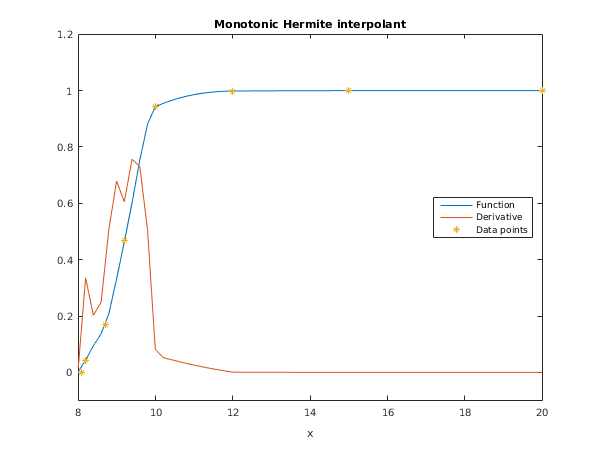PDF version (NAG web site
, 64-bit version, 64-bit version)
NAG Toolbox: nag_interp_1d_monotonic_deriv (e01bg)
Purpose
nag_interp_1d_monotonic_deriv (e01bg) evaluates a piecewise cubic Hermite interpolant and its first derivative at a set of points.
Syntax
Description
nag_interp_1d_monotonic_deriv (e01bg) evaluates a piecewise cubic Hermite interpolant, as computed by
nag_interp_1d_monotonic (e01be), at the points
, for
. The first derivatives at the points are also computed. If any point lies outside the interval from
to
, values of the interpolant and its derivative are extrapolated from the nearest extreme cubic, and a warning is returned.
If values of the interpolant only, and not of its derivative, are required,
nag_interp_1d_monotonic_eval (e01bf) should be used.
The function is derived from function PCHFD in
Fritsch (1982).
References
Fritsch F N (1982) PCHIP final specifications Report UCID-30194 Lawrence Livermore National Laboratory
Parameters
Compulsory Input Parameters
- 1:
– double array
- 2:
– double array
- 3:
– double array
-
n,
x,
f and
d must be unchanged from the previous call of
nag_interp_1d_monotonic (e01be).
- 4:
– double array
-
The values of at which the interpolant is to be evaluated.
Optional Input Parameters
- 1:
– int64int32nag_int scalar
-
Default:
the dimension of the arrays
x,
f,
d. (An error is raised if these dimensions are not equal.)
n,
x,
f and
d must be unchanged from the previous call of
nag_interp_1d_monotonic (e01be).
- 2:
– int64int32nag_int scalar
-
Default:
the dimension of the array
px.
, the number of points at which the interpolant is to be evaluated.
Constraint:
.
Output Parameters
- 1:
– double array
-
contains the value of the interpolant evaluated at the point , for .
- 2:
– double array
-
contains the first derivative of the interpolant evaluated at the point , for .
- 3:
– int64int32nag_int scalar
unless the function detects an error (see
Error Indicators and Warnings).
Error Indicators and Warnings
Errors or warnings detected by the function:
Cases prefixed with W are classified as warnings and
do not generate an error of type NAG:error_n. See nag_issue_warnings.
-
-
-
-
The values of , for , are not in strictly increasing order.
-
-
- W
-
At least one of the points , for , lies outside the interval [], and extrapolation was performed at all such points. Values computed at these points may be very unreliable.
-
An unexpected error has been triggered by this routine. Please
contact
NAG.
-
Your licence key may have expired or may not have been installed correctly.
-
Dynamic memory allocation failed.
Accuracy
The computational errors in the arrays
pf and
pd should be negligible in most practical situations.
Further Comments
The time taken by
nag_interp_1d_monotonic_deriv (e01bg) is approximately proportional to the number of evaluation points,
. The evaluation will be most efficient if the elements of
px are in nondecreasing order (or,
more generally, if they are grouped in increasing order of the intervals
). A
single call of
nag_interp_1d_monotonic_deriv (e01bg) with
is more efficient than several calls with
.
Example
This example reads in values of
n,
x,
f and
d, and calls
nag_interp_1d_monotonic_deriv (e01bg) to compute the values of the interpolant and its derivative at equally spaced points.
Open in the MATLAB editor:
e01bg_example
function e01bg_example
fprintf('e01bg example results\n\n');
x = [7.99 8.09 8.19 8.7 9.2 10 12 15 20];
f = [0 2.7643e-05 0.04375 0.16918 0.46943 0.94374 0.99864 0.99992 0.99999];
d = [0;
0.00055251;
0.33587;
0.34944;
0.59696;
0.060326;
0.000898335;
2.93954e-05;
0];
m = 11;
dx = (x(end)-x(1))/(m-1);
px = [x(1):dx:x(end)];
[pf, pd, ifail] = e01bg(x, f, d, px);
fprintf('\n Interpolated Interpolated\n');
fprintf(' Abscissa Value Derivative\n');
fprintf('%13.4f%15.4f%15.3e\n', [px' pf pd]');
m = 61;
dx = (x(end)-x(1))/(m-1);
px = [x(1):dx:x(end)];
[pf, pd, ifail] = e01bg(x, f, d, px);
fig1 = figure;
plot(px,pf,px,pd,x,f,'*');
legend('Function','Derivative','Data points','Location','East');
title('Monotonic Hermite interpolant');
xlabel('x');
axis([8 20 -0.1 1.2]);
e01bg example results
Interpolated Interpolated
Abscissa Value Derivative
7.9900 0.0000 0.000e+00
9.1910 0.4640 6.060e-01
10.3920 0.9645 4.569e-02
11.5930 0.9965 9.917e-03
12.7940 0.9992 6.249e-04
13.9950 0.9998 2.708e-04
15.1960 0.9999 2.809e-05
16.3970 1.0000 2.034e-05
17.5980 1.0000 1.308e-05
18.7990 1.0000 6.297e-06
20.0000 1.0000 -3.388e-21
PDF version (NAG web site
, 64-bit version, 64-bit version)
© The Numerical Algorithms Group Ltd, Oxford, UK. 2009–2015
